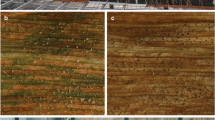Abstract
Auto-infection (infection arising from inoculum produced on the same host unit) is common in polycyclic plant pathogens, but often neglected in experimental and theoretical studies, which focus instead on infection of new hosts (allo-infection). Here we test the hypothesis that high auto-infection, as observed for leaf infecting fungal pathogens, could select for short latent periods. An individual-based simulation model keeps track of lesions, resulting from the spread of spores, between and within individual leaves. Linked to a trade-off between latent period and spore production capacity, as observed for Puccinia triticina on wheat, the adaptation of the latent period is analysed for different levels of auto-infection using the methods of pairwise invasibility plots. Results suggest that increased auto-infection selects for reduced latent periods. A reduction in leaf longevity also selects for reduced latent periods, which is most obvious for a relatively low ratio of auto- to allo-infection. This study is the first to consider the effect of auto-infection on the evolution of pathogen life history traits. The fact that auto-infection could drastically reduce pathogen latent periods highlights the need for more research in this area.






Similar content being viewed by others
References
Alizon S, Taylor P (2008) Empty sites can promote altruistic behaviour. Evolution 62:1335–1344
Anderson RM, May RM (1982) Coevolution of hosts and parasites. Parasitology 85:411–426
Anderson RM, May RM (1991) Infectious diseases of humans: dynamics and control. Oxford University Press, Oxford
Andrivon D, Montarry J, Corbiere R, Glais I, Magalon H, Pasco C (2009) Phytophthora infestans: a life of evolutionary compromises. In: Gadoury DM, Seem RC, Moyer MM, Fry WE (eds) 10th international epidemiology workshop. New York State Agricultural Experiment Station, New York
Antonovics J, Alexander HM (1989) The concept of fitness in plant-fungal pathogen systems. In: Leonard KJ, Fry WE (eds) Plant disease epidemiology: genetics, resistance and management. McGraw-Hill, Inc, New York, pp 185–214
Barrett JA (1980) Pathogen evolution in multilines and variety mixtures. Z Pflanzenk Pflanzen 87:383–396
Begon M, Harper JL, Townsend CR (1990) Life-history variation. Ecology: individuals, populations and communities. Blackwell Science, Inc, Cambridge
Caraco T, Wang I-N (2008) Free-living pathogens: life-history constraints and strain competition. J Theor Biol 250:569–579
Cooke BM, Gareth Jones D, Kaye B (2006) The epidemiology of plant diseases. Springer, Dordrecht
Day T, Taylor PD (2000) A generalization of Pontryagin’s maximum principle for dynamics evolutionary games among relatives. Theor Popul Biol 57:339–356
de Jong TJ, Klinkhamer PGL, de Heijden JLH (2000) The evolution of generation time in metapopulations of monocarpic perennial plants: some theoretical considerations and the example of the rare thistle Carlina vulgaris. Evol Ecol 14:213–231
Dieckmann U, Metz JAJ, Sabelis MW, Sigmund K (2002) Adaptive dynamics of infectious diseases. In pursuit of virulence management. Cambridge University Press, Cambridge
Escarmis C, Lazaro E, Manrubia SC (2006) Population bottlenecks in quasispecies dynamics. Curr Top Microbiol 299:144–170
Frezal L, Robert C, Bancal MO, Lannou C (2009) Local dispersal of Puccinia triticina and wheat canopy structure. Phytopathology 99:1216–1224
Geritz SHA, Kisdi E, Meszena G, Metz JAJ (1998) Evolutionary singular strategies and the adaptive growth and branching of the evolutionary tree. Evol Ecol 12:35–57
Grimm V, Berger U, Bastiansen F, Eliassen S, Ginot V, Giske J, Goss-Custard J, Grand T, Heinz SK, Huse G, Huth A, Jepsen JU, Jorgensen C, Mooij WM, Müller B, Pe’er G, Piou C, Railsback SF, Robbins AM, Robbins MM, Rossmanith E, Rüger N, Strand E, Souissi S, Stillman RA, Vabo R, Visser U, DeAngelis DL (2006) A standard protocol for describing individual-based and agent-based models. Ecol Model 198:115–126
Heraudet V, Salvaudon L, Shykoff JA (2008) Trade-off between latent period and transmission success of a plant pathogen revealed by phenotypic correlations. Evol Ecol Res 10:913–924
Lannou C (2001) Intrapathotype diversity for aggressiveness and pathogen evolution in cultivar mixtures. Phytopathology 91:500–510
Lannou C (2012) Variation and selection of quantitative traits in plant pathogens. Annu Rev Phytopathol 50. doi:10.1146/annurev-phyto-081211-173031
Lannou C, Soubeyrand S, Frezal L, Chadoeuf J (2008) Autoinfection in wheat leaf rust epidemics. New Phytol 177:1001–1011
Lehman JS, Shaner G (1996) Genetic variation in latent period among isolates of Puccinia f. sp. tritici on partially resistant wheat cultivars. Phytopathology 86:633–641
Lehman JS, Shaner G (1997) Selection of populations of Puccinia recondita f. sp. tritici for shortened latent period on a partially resistant wheat cultivar. Phytopathology 87:170–176
Metz JAJ, Gyllenberg M (2001) How should we define fitness in structured metapopulation models? Including an application to the calculation of evolutionary stable dispersal strategies. Proc Roy Soc B-Biol Sci 268:499–508
Milne A, Paveley N, Audsley E, Livermore P (2003) A wheat canopy model for use in disease management decision support systems. Ann Appl Biol 143:265–274
Montarry J, Corbiere R, Andrivon D (2007) Is there a trade-off between aggressiveness and overwinter survival in Phytophthora infestans? Funct Ecol 21:603–610
Mundt CC (2002) Use of multiline cultivar mixtures for disease management. Annu Rev Phytopathol 40:381–410
Mundt CC (2009) Importance of auto-infection to the epidemiology of polycyclic foliar disease. Phytopathology 99:1116–1120
Nelson RR (1979) The evolution of parasitic fitness. In: Horsfall JG, Cowling EB (eds) Plant disease: an advanced treatise. Academic Press, London, pp 23–46
Østergaard H (1983) Predicting development of epidemics on cultivar mixtures. Phytopathology 73:166–172
Pady SM, Kramer CL, Pathak VK, Morgan FL, Bhatti MA (1965) Periodicity in airborne cereal rust urediospores. Phytopathology 55:132–134
Pariaud B, Robert C, Goyeau H, Lannou C (2009) Aggressiveness components and adaptation to a host cultivar in wheat leaf rust. Phytopathology 99:869–878
Pariaud B, van den Berg F, van den Bosch F, Powers SJ, Kaltz O, Lannou C (2012) Pathogen and host identity influence a trade-off between latent period and spore production capacity in the leaf rust pathogen, Puccinia triticina. Evol Appl (in press)
Pels B, de Roos AM, Sabelis MW (2002) Evolutionary dynamics of prey exploitation in a metapopulation of predators. Am Nat 159:172–189
Pringle A, Taylor JW (2002) The fitness of filamentous fungi. Trends Microbiol 10:474–481
Rime D, Robert C, Goyeau H, Lannou C (2005) Effect of host genotype on leaf rust (Puccinia triticina) lesion development and urediniospore production in wheat seedlings. Plant Pathol 54:287–298
Robert C, Bancal MO, Lannou C (2002) Wheat leaf rust uredospore production and carbon and nitrogen export in relation to lesion size and density. Phytopathology 92:762–768
Robert C, Bancal MO, Lannou C (2004) Wheat leaf rust uredospore production on adult plants: influence of leaf nitrogen content and Septoria tritici Blotch. Phytopathology 94:712–721
Robinson RA (1976) Plant pathosystems. Springer, Berlin
Sackett KE, Mundt CC (2005) The effects of dispersal gradient and pathogen life cycle components on epidemic velocity in computer simulations. Phytopathology 95:992–1000
Sacristan S, Garcia-Arenal F (2008) The evolution of virulence and pathogenicity in plant pathogen populations. Mol Plant Pathol 9:369–384
Salathé M, Kouyos RD, Regoes RR, Bonhoeffer S (2007) Rapid parasite adaptation drives selection for high recombination rates. Evolution 62:295–300
Schoeny A, Menat J, Darsonval A, Rouault F, Jumel S, Tivoli B (2008) Effect of pea canopy architecture on splash dispersal of Mycospaerella pinodes conidia. Plant Pathol 57:1073–1085
Tellier A, Brown JKM (2007) Stability of genetic polymorphism in host-parasite interactions. Proc Roy Soc B-Biol Sci 274:809–817
van den Berg F, van den Bosch F (2004) A model for the evolution of pathogen-induced leaf shedding. Oikos 107:36–49
van den Berg F, Robert C, Shaw MW, van den Bosch F (2007) Apical leaf necrosis and leaf nitrogen dynamics in diseased leaves: a model study. Plant Pathol 56:424–436
van den Berg F, Bacaer N, Metz JAJ, Lannou C, van den Bosch F (2011) Periodic host absence can select for both higher or lower parasite transmission rates. Evol Ecol 25:121–137
Wahl LM, Gerrish PJ, Saika-Voivod I (2002) Evaluating the impact of population bottlenecks in experimental evolution. Genetics 162:961–971
Waxman D, Gavrilets S (2005) 20 questions on adaptive dynamics. J Evolution Biol 18:1139–1154
Acknowledgments
This work was partly funded through a BBSRC-INRA project entitled “Epidemiological and evolutionary models for invasion and persistence of disease”. Rothamsted Research receives support from the Biotechnology and Biological Sciences Research Council of the United Kingdom. CAG gratefully acknowledges support of a BBSRC Professional Fellowship. The authors would like to thank an anonymous referee who drew our attention to the alternative hypothesis of kin selection.
Author information
Authors and Affiliations
Corresponding author
Electronic supplementary material
Below is the link to the electronic supplementary material.
Rights and permissions
About this article
Cite this article
van den Berg, F., Gaucel, S., Lannou, C. et al. High levels of auto-infection in plant pathogens favour short latent periods: a theoretical approach. Evol Ecol 27, 409–428 (2013). https://doi.org/10.1007/s10682-012-9602-2
Received:
Accepted:
Published:
Issue Date:
DOI: https://doi.org/10.1007/s10682-012-9602-2




